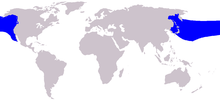Baird's beaked whale
| Baird's beaked whale Temporal range: Middle Miocene to present,
| |
|---|---|

| |
| Illustration of Baird's beaked whale | |
| Scientific classification | |
| Kingdom: | Animalia |
| Phylum: | Chordata |
| Class: | Mammalia |
| Order: | Artiodactyla |
| Infraorder: | Cetacea |
| Family: | Ziphiidae |
| Genus: | Berardius |
| Species: | B. bairdii
|
| Binomial name | |
| Berardius bairdii Duvernoy, 1851
| |

| |
| Baird's beaked whale range | |

Baird’s beaked whale (Berardius bairdii) or the northern giant bottlenose whale, North Pacific bottlenose whale, giant four-toothed whale, northern four-toothed whale, or the North Pacific four-toothed whale is a species of whale from the genus Berardius. Baird's and Arnoux's beaked whales are so similar that researchers have debated whether or not they are simply two populations of the same species. However, genetic evidence and their wide geographical separation has led them to be classified as separate.
Description[]
The species reaches lengths of about 11.9 m for males and 12.8 m for females.[2] The snout, called a beak, is elongated and lacks all teeth except for one or two sets in the lower mandible, which are called "battle teeth" for their use in intra-species conflict. Individuals often bear scars from such confrontations.
Baird's beaked whale can live for up to 84 years.[3]
Distribution[]
The species occurs the North Pacific Ocean and the Japan, Okhotsk, and Bering Seas. It is a deep-water species, primarily frequenting depths between 1,000 m and 3,000 m.
References[]
- ^ Taylor, B.L.; Brownell Jr.; R.L. (2020). "Berardius bairdii". IUCN Red List of Threatened Species. 2020: e.T2763A50351457. doi:10.2305/IUCN.UK.2020-3.RLTS.T2763A50351457.en. Retrieved 19 November 2021.
- ^ "Berardius bairdii". fao.org. Food and Agriculture Organization of the United Nations. Retrieved 2021-07-15.
- ^ "Berardius bairdii". The Moirai - Aging Research. 2016-10-19. Archived from the original on 21 November 2016. Retrieved 2016-11-20.
- IUCN Red List least concern species
- Ziphiids
- Cetacean stubs
